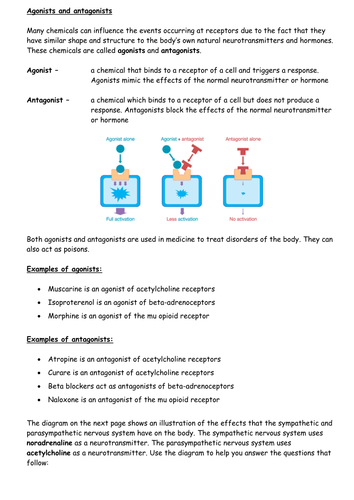

A worksheet aimed at advanced level biology students, this resource focuses on the mechanism of action of agonists and antagonists. The worksheet includes a diagram and explanation of how agonists and antagonists work, followed by some examples of common drugs and chemicals that can act as agonists or antagonists of the autonomic nervous system.
A diagram of the parasympathetic and sympathetic branches of the autonomic nervous system is included and is required for the final page of the worksheet - a series of questions that asks students to predict the effect of various drugs and poisons (e.g. beta blockers, muscarine, atropine, etc).
This is a good activity for making the link between theory and practice; most students really enjoy being able to predict the action of a drug from a simple understanding of its mechanism.
A second, shorter worksheet is also included on the same topic which could be used as a revision activity once the key concepts have been taught.
Key words: agonist, anatgonist, sympathetic, parasympathetic, sympathetic, autonomic, muscarine, beta blockers, atropine, noradrenaline, acetylcholine, sarin
A diagram of the parasympathetic and sympathetic branches of the autonomic nervous system is included and is required for the final page of the worksheet - a series of questions that asks students to predict the effect of various drugs and poisons (e.g. beta blockers, muscarine, atropine, etc).
This is a good activity for making the link between theory and practice; most students really enjoy being able to predict the action of a drug from a simple understanding of its mechanism.
A second, shorter worksheet is also included on the same topic which could be used as a revision activity once the key concepts have been taught.
Key words: agonist, anatgonist, sympathetic, parasympathetic, sympathetic, autonomic, muscarine, beta blockers, atropine, noradrenaline, acetylcholine, sarin
Get this resource as part of a bundle and save up to 30%
A bundle is a package of resources grouped together to teach a particular topic, or a series of lessons, in one place.
Something went wrong, please try again later.
This resource hasn't been reviewed yet
To ensure quality for our reviews, only customers who have purchased this resource can review it
Report this resourceto let us know if it violates our terms and conditions.
Our customer service team will review your report and will be in touch.
£3.00
